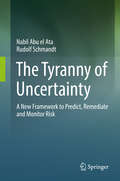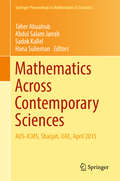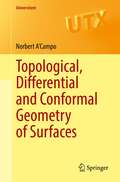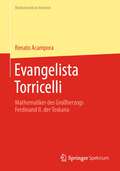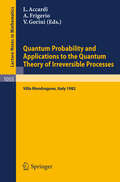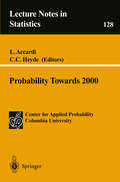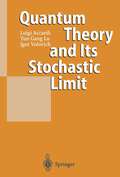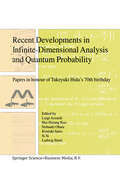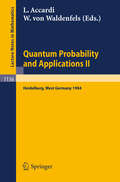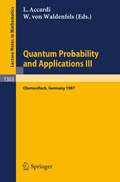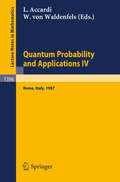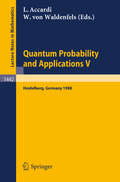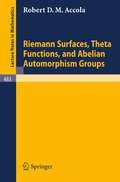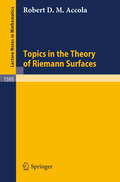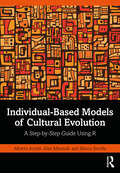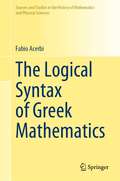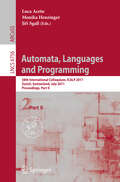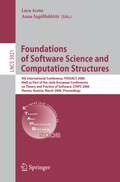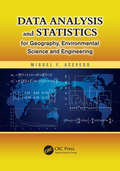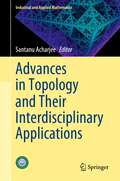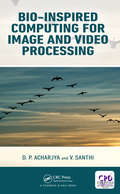- Table View
- List View
The Tyranny of Uncertainty: A New Framework to Predict, Remediate and Monitor Risk
by Nabil Abu el Ata Rudolf SchmandtThe authors offer a revolutionary solution to risk management. It’s the unknown risks that keep leaders awake at night—wondering how to prepare for and steer their organization clear from that which they cannot predict. Businesses, governments and regulatory bodies dedicate endless amounts of time and resources to the task of risk management, but every leader knows that the biggest threats will come from some new chain of events or unexpected surprises—none of which will be predicted using conventional wisdom or current risk management technologies and so management will be caught completely off guard when the next crisis hits. By adopting a scientific approach to risk management, we can escape the limited and historical view of experience and statistical based risk management models to expose dynamic complexity risks and prepare for new and never experienced events.
Mathematics Across Contemporary Sciences: AUS-ICMS, Sharjah, UAE, April 2015 (Springer Proceedings in Mathematics & Statistics #190)
by Taher Abualrub Abdul Salam Jarrah Sadok Kallel Hana SuliemanThis work presents invited contributions from the second "International Conference on Mathematics and Statistics" jointly organized by the AUS (American University of Sharjah) and the AMS (American Mathematical Society). Addressing several research fields across the mathematical sciences, all of the papers were prepared by faculty members at universities in the Gulf region or prominent international researchers. The current volume is the first of its kind in the UAE and is intended to set new standards of excellence for collaboration and scholarship in the region.
Topological, Differential and Conformal Geometry of Surfaces (Universitext)
by Norbert A'CampoThis book provides an introduction to the main geometric structures that are carried by compact surfaces, with an emphasis on the classical theory of Riemann surfaces. It first covers the prerequisites, including the basics of differential forms, the Poincaré Lemma, the Morse Lemma, the classification of compact connected oriented surfaces, Stokes’ Theorem, fixed point theorems and rigidity theorems. There is also a novel presentation of planar hyperbolic geometry. Moving on to more advanced concepts, it covers topics such as Riemannian metrics, the isometric torsion-free connection on vector fields, the Ansatz of Koszul, the Gauss–Bonnet Theorem, and integrability. These concepts are then used for the study of Riemann surfaces. One of the focal points is the Uniformization Theorem for compact surfaces, an elementary proof of which is given via a property of the energy functional. Among numerous other results, there is also a proof of Chow’s Theorem on compact holomorphic submanifolds in complex projective spaces. Based on lecture courses given by the author, the book will be accessible to undergraduates and graduates interested in the analytic theory of Riemann surfaces.
Evangelista Torricelli: Mathematiker des Großherzogs Ferdinand II. der Toskana (Mathematik im Kontext)
by Renato AcamporaDie meisten Nichtmathematiker werden Torricelli durch das nach ihm benannte Ausflussgesetz kennen, wonach die Geschwindigkeit eines aus einem Gefäss austretenden Wasserstrahls proportional zur Quadratwurzel aus der Füllhöhe ist, ebenso wie durch seinen Nachweis des Luftdrucks mithilfe seines Vakuumexperiments. Viel bedeutender aber sind seine Leistungen auf dem Gebiet der Mathematik als virtuoser Vertreter von Cavalieris umstrittener Indivisiblenmethode, wobei er seine Ergebnisse aber stets mit Beweisen nach der allgemein anerkannten „Art der Alten“ absicherte. Auf diese Weise gelang ihm die Quadratur der Parabeln und Hyperbeln höherer Ordnung, der Zykloide, der logarithmischen Spirale (ebenso wie deren Rektifikation) und die Bestimmung der Schwerpunkte zahlreicher ebener und räumlicher Figuren.
Quantum Probability and Applications to the Quantum Theory of Irreversible Processes: Proceedings of the International Workshop held at Villa Mondragone, Italy, September 6-11, 1982 (Lecture Notes in Mathematics #1055)
by L. Accardi A. Frigerio V. GoriniProbability Towards 2000 (Lecture Notes in Statistics #128)
by L. Accardi C. C. HeydeSenior probabilists from around the world with widely differing specialities gave their visions of the state of their specialty, why they think it is important, and how they think it will develop in the new millenium. The volume includes papers given at a symposium at Columbia University in 1995, but papers from others not at the meeting were added to broaden the coverage of areas. All papers were refereed.
Quantum Theory and Its Stochastic Limit
by Luigi Accardi Yun Gang Lu Igor VolovichWell suited as a textbook in the emerging field of stochastic limit, which is a new mathematical technique developed for solving nonlinear problems in quantum theory.
Recent Developments in Infinite-Dimensional Analysis and Quantum Probability: Papers in Honour of Takeyuki Hida’s 70th Birthday
by Luigi Accardi L. Streit Hui-Hsiung Hui-Hsiung Kuo Nobuaki Obata Kimiaki Saito Si Si SiRecent Developments in Infinite-Dimensional Analysis and Quantum Probability is dedicated to Professor Takeyuki Hida on the occasion of his 70th birthday. The book is more than a collection of articles. In fact, in it the reader will find a consistent editorial work, devoted to attempting to obtain a unitary picture from the different contributions and to give a comprehensive account of important recent developments in contemporary white noise analysis and some of its applications. For this reason, not only the latest results, but also motivations, explanations and connections with previous work have been included. The wealth of applications, from number theory to signal processing, from optimal filtering to information theory, from the statistics of stationary flows to quantum cable equations, show the power of white noise analysis as a tool. Beyond these, the authors emphasize its connections with practically all branches of contemporary probability, including stochastic geometry, the structure theory of stationary Gaussian processes, Neumann boundary value problems, and large deviations.
Quantum Probability and Applications II: Proceedings of a Workshop held in Heidelberg, West Germany, October 1-5, 1984 (Lecture Notes in Mathematics #1136)
by Luigi Accardi Wilhelm V. WaldenfelsQuantum Probability and Applications III: Proceedings of a Conference held in Oberwolfach, FRG, January 25-31, 1987 (Lecture Notes in Mathematics #1303)
by Luigi Accardi Wilhelm V. WaldenfelsThese proceedings of the first Quantum Probability meeting held in Oberwolfach is the fourth in a series begun with the 1982 meeting of Mondragone and continued in Heidelberg ('84) and in Leuven ('85). The main topics discussed were: quantum stochastic calculus, mathematical models of quantum noise and their applications to quantum optics, the quantum Feynman-Kac formula, quantum probability and models of quantum statistical mechanics, the notion of conditioning in quantum probability and related problems (dilations, quantum Markov processes), quantum central limit theorems. With the exception of Kümmerer's review article on Quantum Markov Processes, all contributions are original research papers.
Quantum Probability and Applications IV: Proceedings of the Year of Quantum Probability, held at the University of Rome II, Italy, 1987 (Lecture Notes in Mathematics #1396)
by Luigi Accardi Wilhelm V. WaldenfelsThis volume, the fourth of the quantum probability series, collects part of the contributions to the Year of Quantum Probability organized by the Volterra Center of University of Rome II. The intensive communication among researchers during this Year allowed several open problems to be solved and several inexpected connections to be revealed.
Quantum Probability and Applications V: Proceedings of the Fourth Workshop, held in Heidelberg, FRG, Sept. 26-30, 1988 (Lecture Notes in Mathematics #1442)
by Luigi Accardi Wilhelm V. WaldenfelsThese proceedings of the workshop on quantum probability held in Heidelberg, September 26-30, 1988 contains a representative selection of research articles on quantum stochastic processes, quantum stochastic calculus, quantum noise, geometry, quantum probability, quantum central limit theorems and quantum statistical mechanics.
Riemann Surfaces, Theta Functions, and Abelian Automorphisms Groups (Lecture Notes in Mathematics #483)
by R.D.M. AccolaTopics in the Theory of Riemann Surfaces (Lecture Notes in Mathematics #1595)
by Robert D.M. AccolaThe book's main concern is automorphisms of Riemann surfaces, giving a foundational treatment from the point of view of Galois coverings, and treating the problem of the largest automorphism group for a Riemann surface of a given genus. In addition, the extent to which fixed points of automorphisms are generalized Weierstrass points is considered. The extremely useful inequality of Castelnuovo- Severi is also treated. While the methods are elementary, much of the material does not appear in the current texts on Riemann surfaces, algebraic curves. The book is accessible to a reader who has had an introductory course on the theory of Riemann surfaces or algebraic curves.
Individual-Based Models of Cultural Evolution: A Step-by-Step Guide Using R
by Alberto Acerbi Alex Mesoudi Marco SmollaIndividual-Based Models of Cultural Evolution shows readers how to create individual-based models of cultural evolution using the programming language R. The field of cultural evolution has emerged in the last few decades as a thriving, interdisciplinary effort to understand cultural change and cultural diversity within an evolutionary framework and using evolutionary tools, concepts, and methods. Given its roots in evolutionary biology, much of cultural evolution is grounded in, or inspired by, formal models. Yet many researchers interested in cultural evolution come from backgrounds that lack training in formal modelling, such as psychology, anthropology or archaeology. This book addresses that gap. It provides example code in R for readers to run their own models, moving from very simple models of the basic processes of cultural evolution, such as biased transmission and cultural mutation, to more advanced topics such as the evolution of social learning, demographic effects, and social network analysis. Features of this book: Recreates existing models in the literature to show how these were created and to enable readers to have a better understanding of their significance and how to apply them to their own research questions Provides full R code to realize models and analyse and plot outputs, with line-by-line analysis Requires no previous knowledge of the field of cultural evolution, and only very basic programming knowledge This is an essential resource for researchers and students interested in cultural evolution, including disciplines such as psychology, anthropology, archaeology, and biology as well as sociology and digital humanities.
Individual-Based Models of Cultural Evolution: A Step-by-Step Guide Using R
by Alberto Acerbi Alex Mesoudi Marco SmollaIndividual-Based Models of Cultural Evolution shows readers how to create individual-based models of cultural evolution using the programming language R. The field of cultural evolution has emerged in the last few decades as a thriving, interdisciplinary effort to understand cultural change and cultural diversity within an evolutionary framework and using evolutionary tools, concepts, and methods. Given its roots in evolutionary biology, much of cultural evolution is grounded in, or inspired by, formal models. Yet many researchers interested in cultural evolution come from backgrounds that lack training in formal modelling, such as psychology, anthropology or archaeology. This book addresses that gap. It provides example code in R for readers to run their own models, moving from very simple models of the basic processes of cultural evolution, such as biased transmission and cultural mutation, to more advanced topics such as the evolution of social learning, demographic effects, and social network analysis. Features of this book: Recreates existing models in the literature to show how these were created and to enable readers to have a better understanding of their significance and how to apply them to their own research questions Provides full R code to realize models and analyse and plot outputs, with line-by-line analysis Requires no previous knowledge of the field of cultural evolution, and only very basic programming knowledge This is an essential resource for researchers and students interested in cultural evolution, including disciplines such as psychology, anthropology, archaeology, and biology as well as sociology and digital humanities.
The Logical Syntax of Greek Mathematics (Sources and Studies in the History of Mathematics and Physical Sciences)
by Fabio AcerbiThe aim of this monograph is to describe Greek mathematics as a literary product, studying its style from a logico-syntactic point of view and setting parallels with logical and grammatical doctrines developed in antiquity. In this way, major philosophical themes such as the expression of mathematical generality and the selection of criteria of validity for arguments can be treated without anachronism. Thus, the book is of interest for both historians of ancient philosophy and specialists in Ancient Greek, in addition to historians of mathematics.This volume is divided into five parts, ordered in decreasing size of the linguistic units involved. The first part describes the three stylistic codes of Greek mathematics; the second expounds in detail the mechanism of "validation"; the third deals with the status of mathematical objects and the problem of mathematical generality; the fourth analyzes the main features of the "deductive machine," i.e. the suprasentential logical system dictated by the traditional division of a mathematical proposition into enunciation, setting-out, construction, and proof; and the fifth deals with the sentential logical system of a mathematical proposition, with special emphasis on quantification, modalities, and connectors. A number of complementary appendices are included as well.
Automata, Languages and Programming: 38th International Colloquium, ICALP 2011, Zurich, Switzerland, July 4-8, 2010. Proceedings, Part II (Lecture Notes in Computer Science #6756)
by Luca Aceto Monika Henzinger Jiri SgallThe two-volume set LNCS 6755 and LNCS 6756 constitutes the refereed proceedings of the 38th International Colloquium on Automata, Languages and Programming, ICALP 2011, held in Zürich, Switzerland, in July 2011. The 114 revised full papers (68 papers for track A, 29 for track B, and 17 for track C) presented together with 4 invited talks, 3 best student papers, and 3 best papers were carefully reviewed and selected from a total of 398 submissions. The papers are grouped in three major tracks on algorithms, complexity and games; on logic, semantics, automata, and theory of programming; as well as on foundations of networked computation: models, algorithms and information management.
Foundations of Software Science and Computational Structures: 9th International Conference, FOSSACS 2006, Held as Part of the Joint European Conferences on Theory and Practice of Software, ETAPS 2006, Vienna, Austria, March 25-31, 2006, Proceedings (Lecture Notes in Computer Science #3921)
by Luca Aceto Anna IngólfsdóttirThis book constitutes the refereed proceedings of the 9th International Conference on Foundations of Software Science and Computation Structures, FOSSACS 2006, held in Vienna, Austria in March 2006 as part of ETAPS. The 28 revised full papers presented together with one invited paper were carefully reviewed and selected from 107 submissions. The papers are organized in topical sections.
Data Analysis and Statistics for Geography, Environmental Science, and Engineering
by Miguel F. AcevedoProviding a solid foundation for twenty-first-century scientists and engineers, Data Analysis and Statistics for Geography, Environmental Science, and Engineering guides readers in learning quantitative methodology, including how to implement data analysis methods using open-source software. Given the importance of interdisciplinary work in sustain
Ay's Neuroanatomy of C. Elegans for Computation (Routledge Revivals)
by Theodore B. Achacoso William S. YamamotoFirst published in 1992, AY's Neuroanatomy of C. elegans for Computation provides the neural circuitry database of the nematode Caenorhabditis elegans, both in printed form and in ASCII files on 5.25-inch diskettes (for use on IBM® and compatible personal computers, Macintosh® computers, and higher level machines). Tables of connections among neuron classes, synapses among individual neurons, gap junctions among neurons, worm cells and their embryonic origin, and synthetically derived neuromuscular connections are presented together with the references from which the data were compiled and edited. Sample data files and source codes of FORTRAN and BASIC programs are provided to illustrate the use of mathematical tools for any researcher or student interested in examining a natural neural network and discovering what makes it tick.
Ay's Neuroanatomy of C. Elegans for Computation (Routledge Revivals)
by Theodore B. Achacoso William S. YamamotoFirst published in 1992, AY's Neuroanatomy of C. elegans for Computation provides the neural circuitry database of the nematode Caenorhabditis elegans, both in printed form and in ASCII files on 5.25-inch diskettes (for use on IBM® and compatible personal computers, Macintosh® computers, and higher level machines). Tables of connections among neuron classes, synapses among individual neurons, gap junctions among neurons, worm cells and their embryonic origin, and synthetically derived neuromuscular connections are presented together with the references from which the data were compiled and edited. Sample data files and source codes of FORTRAN and BASIC programs are provided to illustrate the use of mathematical tools for any researcher or student interested in examining a natural neural network and discovering what makes it tick.
Advances in Topology and Their Interdisciplinary Applications (Industrial and Applied Mathematics)
by Santanu AcharjeeThis book contains selected chapters on recent research in topology. It bridges the gap between recent trends of topological theories and their applications in areas like social sciences, natural sciences, soft computing, economics, theoretical chemistry, cryptography, pattern recognitions and granular computing. There are 14 chapters, including two chapters on mathematical economics from the perspective of topology. The book discusses topics on function spaces, relator space, preorder, quasi-uniformities, bitopological dynamical systems, b-metric spaces and related fixed point theory. This book is useful to researchers, experts and scientists in studying the cutting-edge research in topology and related areas and helps them applying topology in solving real-life problems the society and science are facing these days.
Bio-Inspired Computing for Image and Video Processing
by D. P. Acharjya V. SanthiIn recent years bio-inspired computational theories and tools have developed to assist people in extracting knowledge from high dimensional data. These differ in how they take a more evolutionary approach to learning, as opposed to traditional artificial intelligence (AI) and what could be described as 'creationist' methods. Instead bio-inspired computing takes a bottom-up, de-centralized approach that often involves the method of specifying a set of simple rules, a set of simple organisms which adhere to those rules, and of iteratively applying those rules. Bio-Inspired Computing for Image and Video Processing covers interesting and challenging new theories in image and video processing. It addresses the growing demand for image and video processing in diverse application areas, such as secured biomedical imaging, biometrics, remote sensing, texture understanding, pattern recognition, content-based image retrieval, and more. This book is perfect for students following this topic at both undergraduate and postgraduate level. It will also prove indispensable to researchers who have an interest in image processing using bio-inspired computing.
Bio-Inspired Computing for Image and Video Processing
by D. P. Acharjya V. SanthiIn recent years bio-inspired computational theories and tools have developed to assist people in extracting knowledge from high dimensional data. These differ in how they take a more evolutionary approach to learning, as opposed to traditional artificial intelligence (AI) and what could be described as 'creationist' methods. Instead bio-inspired computing takes a bottom-up, de-centralized approach that often involves the method of specifying a set of simple rules, a set of simple organisms which adhere to those rules, and of iteratively applying those rules. Bio-Inspired Computing for Image and Video Processing covers interesting and challenging new theories in image and video processing. It addresses the growing demand for image and video processing in diverse application areas, such as secured biomedical imaging, biometrics, remote sensing, texture understanding, pattern recognition, content-based image retrieval, and more. This book is perfect for students following this topic at both undergraduate and postgraduate level. It will also prove indispensable to researchers who have an interest in image processing using bio-inspired computing.
